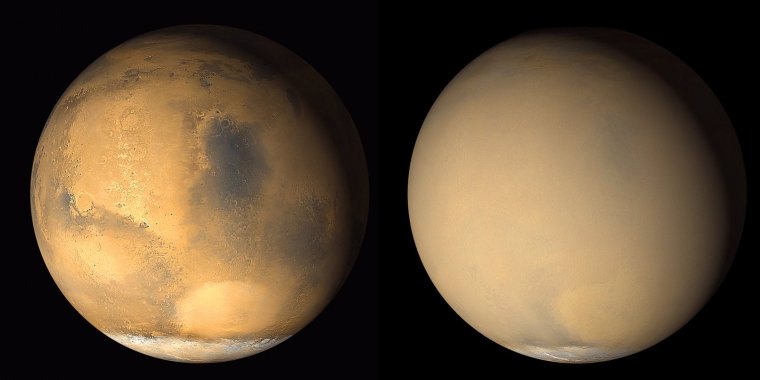| News / Space News |
Dust Storms Linked to Gas Escape from Mars Atmosphere
A study published this week based on observations by NASA's Mars Reconnaissance Orbiter (MRO) during the most recent Martian global dust storm -- in 2007 -- suggests such storms play a role in the ongoing process of gas escaping from the top of Mars' atmosphere. That process long ago transformed wetter, warmer ancient Mars into today's arid, frozen planet.

Two 2001 images from the Mars Orbiter Camera on NASA's Mars Global Surveyor orbiter show a dramatic change in the planet's appearance when haze raised by dust-storm activity in the south became globally distributed. The images were taken about a month apart. Image credit: NASA/JPL-Caltech/MSSS
Using recently refined analysis methods for the 2007 data, the researchers found an increase in water vapor by more than a hundred-fold in the middle atmosphere during that global storm. Water vapor is carried up with the same air mass rising with the dust.
A link between the presence of water vapor in Mars' middle atmosphere -- roughly 30 to 60 miles (50 to 100 kilometers) high -- and escape of hydrogen from the top of the atmosphere has been detected by NASA's Hubble Space Telescope and the European Space Agency's Mars Express orbiter, but mainly in years without the dramatic changes produced in a global dust storm. NASA's MAVEN mission arrived at Mars in 2014 to study the process of atmosphere escape.
Not all Mars watchers are thrilled with the idea of a global dust storm, which can adversely affect ongoing missions. For instance: Opportunity, as a solar powered rover, would have to hunker down to save energy; the upcoming InSight lander's parameters would need to be adjusted for safe entry, descent and landing in November; and all the cameras on rovers and orbiters would need to deal with low visibility.
Decades of Mars observations document a pattern of multiple regional dust storms arising during the northern spring and summer. In most Martian years, which are nearly twice as long as Earth years, all the regional storms dissipate and none swells into a global dust storm. But such expansion happened in 1977, 1982, 1994, 2001 and 2007.
The next Martian dust storm season is expected to begin this summer and last into early 2019. (NASA)
YOU MAY ALSO LIKE




